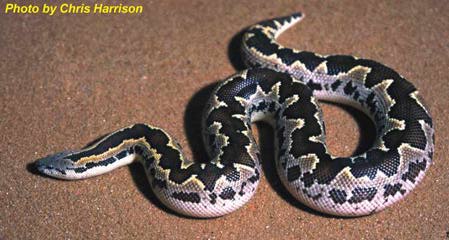
The Rough-scaled Sand Boa (Eryx conicus)
Other images
Adult pair with newborn babies
A link to a photograph of Eryx "whitakeri"
Other names
Common Sand Boa, Russell's Earth Boa
I have followed the taxonomic arrangement of Tokar (1995) in considering E. c. conicus and E. c.
brevis as junior synonyms of the monotypic E. conicus. (That is a technical way of saying that
I agree with Dr. Tokar's conclusion that there are no subspecies of E. conicus).
I also include here the recently described Eryx whitakeri. I have not seen the original description
(Das, 1991), but this new taxon appears to me to represent little more than a dark population of E. conicus.
I am currently trying to get a copy of Das's paper.
Introduction
The Rough-scaled Sand Boa is probably the second most common species of Sand Boa in captivity in the US. This
species is native to India and Pakistan. Although it is called a Sand Boa, it is not restricted to sandy soils, in
fact it is more common in dry steppes, agricultural areas and even into some of the wetter forests of the subcontinent.
It is a fairly common snake in India and is occasionally used by snake charmers.
Adult female E. conicus are much larger than the males. While females can reach lengths of almost 3
feet, males rarely exceed 2 feet. Even at these short lengths, they are very heavy bodied snakes.
Rough-scaled Sand Boas in Captivity
Eryx conicus make good captives. Adults are very docile and easily handled. Juveniles
and babies may occasionally bite until they get used to handling. They bite surprisingly hard for a small snake!
Gravid females may occasionaly bite as well.
These are relatively inactive Sand Boas. They spend much of their time burrowed in the cage substrate with just
their head sticking up, waiting for some unsuspecting prey item to walk by. Those that have hide boxes will spend
most of their time in the hide box with their head sticking out. They don't spend much time crawling around their
cages like some of the other species.
Reproduction
Rough-scaled Sand Boas are easy to breed in captivity. Once the snakes have reached sexual maturity (this takes
approximately 3-4 years for females, when they will weigh around 250 g., only two years for males, who will weigh 60-75 g.) the
male should be placed with the female in mid-February and left with her until late April. Male Sand Boas will
frequently stop feeding during this breeding season. Females that are gravid will begin to spend a lot of time
sitting at the warmest part of the cage and will get very distended on the last half of their bodies. Some females
will not feed when gravid while others will accept small food items throughout the gestation. In late June or early
July the female will give birth to 3-12 large babies during the night. These babies will usually feed on pinkies
after their first shed. This is one of the easier species to start on pink mice.
References
Daniel, J. C. 1989. The Book of Indian Reptiles. Bombay Natural History Society, Oxford University Press, Delhi. 141 pp.
Das, I. 1991. A new species of Eryx from south-west India. J. of the Bombay Nat.Hist. Soc. 88:92-97.
Deoras, P.J. 1978. Snakes of India. 3rd Ed. National Book Trust, India, New Delhi, 155 pp.
Minton, S. A., Jr. 1966. A Contribution to the Herpetology of West Pakistan. Bull. Am. Mus. Nat. Hist. 132(2):119-120.
Tokar, A.A. 1995. Taxonomic revision of the genus Gongylophis Wagler 1830: G. conicus (Schneider 1801)
and G. muelleri Boulenger 1892 (Serpentes Boidae). Tropical Zoology 8:347-360.
Whitaker, R. 1978. Common Indian Snakes: A Field Guide. Macmillan India Ltd., Delhi, 154 pp.
© Chris Harrison
| 

